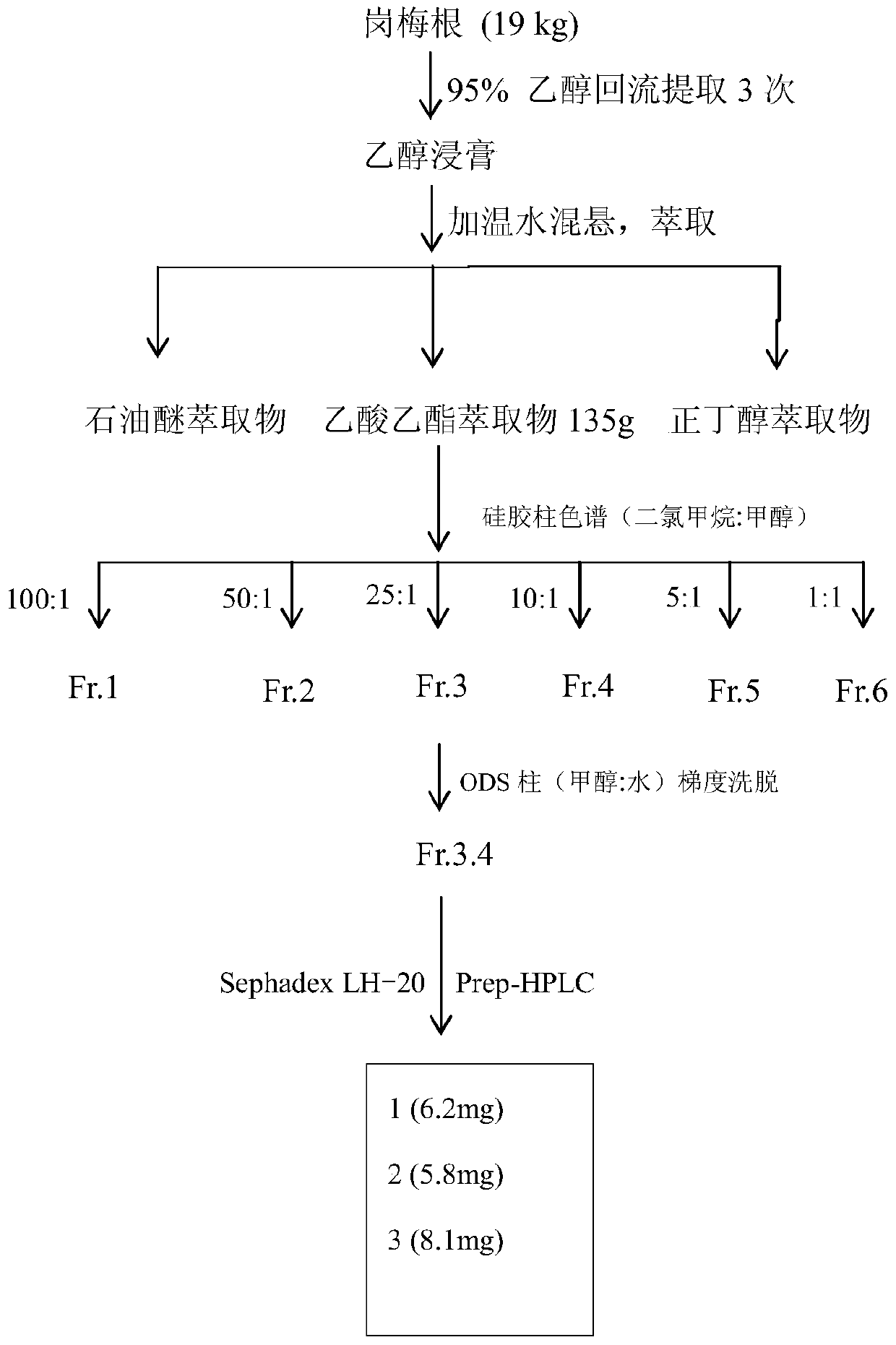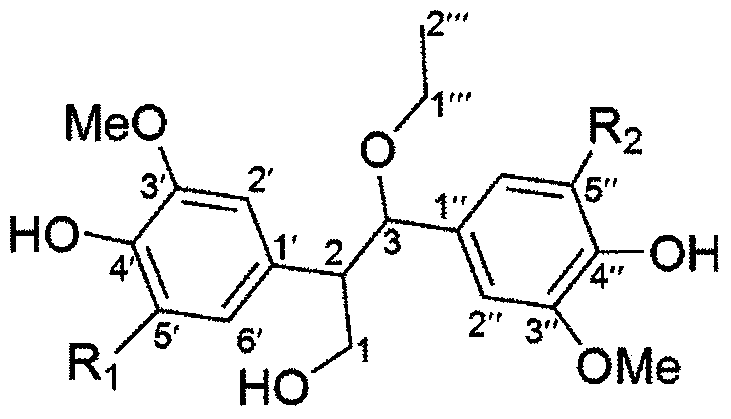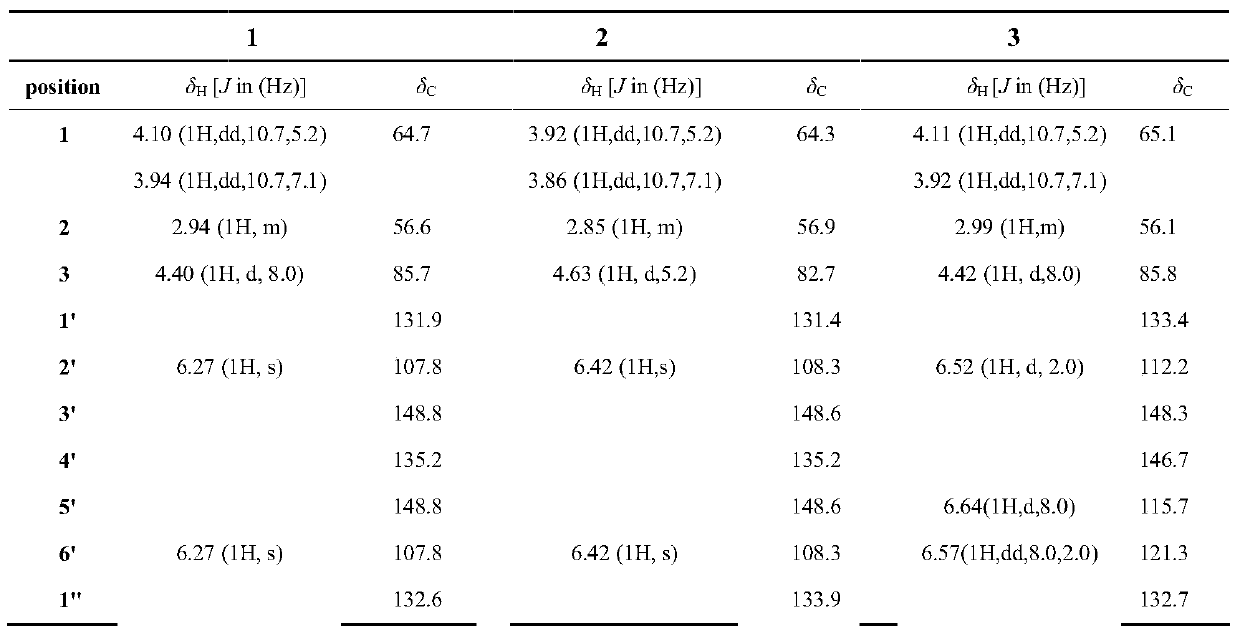Use of aryl-substituted phenylpropanoids in the preparation of anti-complement drugs
A compound, phenylpropanoid technology, applied in the field of aryl-substituted phenylpropanoid compounds to prepare anti-complement drugs, which can solve problems such as excessive activation of the autoimmune system
- Summary
- Abstract
- Description
- Claims
- Application Information
AI Technical Summary
Problems solved by technology
Method used
Image
Examples
Embodiment 1
[0032] Embodiment 1. Preparation of phenylpropanoid compounds
[0033]Take 19 kg of root plum, heat and reflux with 95% ethanol to extract 3 times, suspend the extract with water after concentration, and extract with petroleum ether, ethyl acetate, and n-butanol respectively to obtain 135 g of ethyl acetate in the active part, and take 120 g of the extract to dry The method was applied to silica gel column chromatography, eluted with dichloromethane-methanol gradient (100:1→1:1), and the Fr.3 fraction eluted with dichloromethane-methanol (25:1) was reversed by ODS Column methanol / water (20% → 100%) for gradient elution, ultraviolet 210nm as the detection wavelength, a total of Fr.3 (1-8) fractions, Fr.3.4 and dichloromethane-methanol (20:1) Silica gel column chromatography and Sephadex LH-20 were carried out isocratically to separate, and finally HPLC was used to prepare the liquid phase for purification, and acetonitrile / water (32%) was used as the preparation condition to ob...
Embodiment 2
[0036] Example 2. Anti-complement classical pathway test in vitro
[0037] Take 0.1ml of complement (guinea pig serum), add barbiturate buffer solution (BBS) to prepare a 1:10 solution, and double-dilute with BBS to 1:20, 1:40, 1:80, 1:160, 1:10 320, 1:640 and 1:1280 solutions; take 1:1000 hemolysin, each concentration of complement and 2% sheep red blood cell (SRBC) each 0.1ml dissolved in 0.3ml BBS, mix well, put in 37℃ water bath for 30min Centrifuge at 5000rpm and 4°C for 10min in a low-temperature high-speed centrifuge; take 0.2ml of the supernatant from each tube and put it in a 96-well plate, and measure its absorbance at 405nm; set up a full hemolysis group (0.1ml 2% SRBC dissolved in 0.5ml Triple-distilled water), using the absorbance of triple-distilled water lysed blood vessels as the standard of total hemolysis, calculate the hemolysis rate, take the dilution of complement as the X-axis, and the percentage of hemolysis as the Y-axis to draw a graph, and select the ...
Embodiment 3
[0038] Example 3. Anti-complement alternative pathway test in vitro
[0039] Take 0.2ml of complement (human serum), add AP diluent (barbital buffer, pH=7.4, containing 5mM Mg 2+ ,8mMEGTA) was prepared as a 1:1 solution, which was double-diluted into 1:2, 1:4, 1:8, 1:16, 1:32, 1:64 and 1:128 solutions; each concentration of complement was 0.15 ml, 0.15ml of AP diluent and 0.20ml of 0.5% rabbit red blood cells (RE), mix well, put in a low-temperature high-speed centrifuge after 30 minutes in a water bath at 37°C, and centrifuge at 5000rpm and 4°C for 10 minutes; ml was placed in a 96-well plate, and the absorbance was measured at 405nm. At the same time, a complete hemolysis group (0.20ml 0.5% RE dissolved in 0.3ml triple distilled water) was set up in the experiment. The dilution is plotted on the X-axis, and the percentage of hemolysis is plotted on the Y-axis. The lowest complement concentration that achieves a similarly high hemolysis rate is selected as the critical compl...
PUM
 Login to View More
Login to View More Abstract
Description
Claims
Application Information
 Login to View More
Login to View More - R&D
- Intellectual Property
- Life Sciences
- Materials
- Tech Scout
- Unparalleled Data Quality
- Higher Quality Content
- 60% Fewer Hallucinations
Browse by: Latest US Patents, China's latest patents, Technical Efficacy Thesaurus, Application Domain, Technology Topic, Popular Technical Reports.
© 2025 PatSnap. All rights reserved.Legal|Privacy policy|Modern Slavery Act Transparency Statement|Sitemap|About US| Contact US: help@patsnap.com



